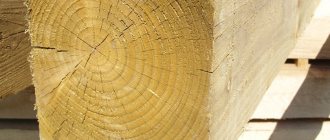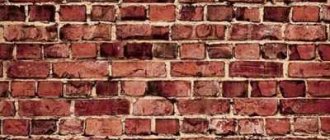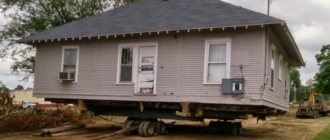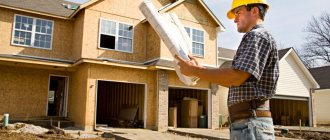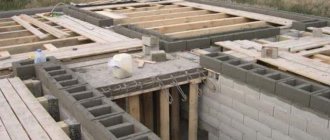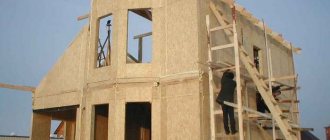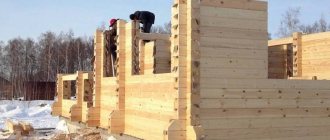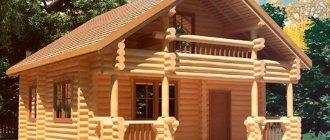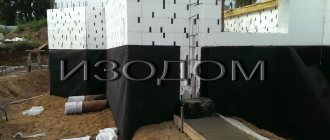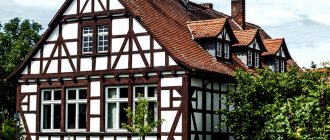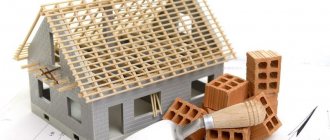Wooden construction is now breaking records in popularity. And this is not just a trend, this is a normal human desire for comfortable and safe housing - this is exactly what a wooden house is. In this material HouseChief.ru we will discuss what the choice of wood should be for building a house. The quality and durability of the structure depends on the choice of material.
A wooden house is the dream of many owners of country plots. This is the most environmentally friendly housing of all existing
Types of wood for building a house
Wood is one of the best materials for building a private house, as it has unique natural qualities. Each of its breeds has individual characteristics. Having understood them, it will be easier to decide which wood is best suited for a particular case.
For private construction, both coniferous and deciduous wood are used. The most popular and affordable conifers are pine and spruce, the more expensive are fir, larch and cedar. Hardwood timber used for building houses is aspen, birch, poplar, oak, alder, linden and maple.
Let's take a closer look at the main characteristics of the most popular breeds.
Softwood
Pine
If we consider all types of wood in general, then, perhaps, pine will be the most used material for building houses. Everything is explained by the prevalence of this wood and its affordability.
Although pine is not without quite significant drawbacks, it remains in the leading positions of popularity among all types of wood used in construction
At the same time, pine lumber that has been properly dried has quite decent performance characteristics. The advantages include the following:
- low shrinkage - this means that a house made of this wood will not shrink much;
- softness - this quality greatly simplifies wood processing;
— moderate density contributes to low thermal conductivity;
— quite good resistance to putrefactive processes;
— evenness of the trunk and a small number of large knots;
— wear resistance;
- low tendency to develop large cracks.
The disadvantages of pine include the following factors:
- the appearance of blue staining, which can lead to destruction of the structure of the material, so it must be combated by treating the wood with special compounds;
— if we compare pine with other types of wood, we can note its lower resistance to rotting and cracking, as well as lower strength characteristics than, say, larch, cedar and oak.
When choosing pine for building a house, it is important to obtain reliable information about the conditions and location of its growth. The best quality is the material obtained from trees grown in the northern regions.
Spruce
Spruce, like pine, is a popular wood for private construction. And this is due to its characteristic positive features:
- low thermal conductivity, achieved due to the friability of wood;
- positive effect on human health, especially on the cardiovascular system;
Spruce wood can maintain a healthy indoor microclimate
- durability of lumber made from this type of wood;
— the presence of natural antibacterial substances in the wood, thanks to which the spruce is not susceptible to blue stain damage;
- spruce wood, like pine, is a low-drying, soft species.
The disadvantages of spruce lumber include the following characteristics:
- low moisture resistance;
- far from the best indicator of strength and wear resistance;
- tendency to the appearance of putrefactive processes;
— a large number of small and large knots, which makes cleaning and aligning the trunk difficult.
If you decide to build a house from spruce lumber, then you need to know that this wood requires initial, and then, during operation, quite frequent periodic treatment with special paints, varnishes and impregnations.
Larch
Larch is excellent for building a house, as it has almost impeccable natural qualities:
Larch is absolutely not afraid of exposure to moisture, does not rot and is characterized by excellent strength.
— high density and strength of wood;
- not susceptible to rotting, blue staining and the negative effects of various microorganisms and insects;
— high fire resistance;
- durability - houses made of larch can last for several centuries;
- moisture resistance and resistance to various atmospheric phenomena - precipitation, temperature changes, infrared exposure;
- beneficial effects on human health - increasing immunity, slowing down the aging of the body.
The disadvantages of larch include the following:
- hardness of the structure, which complicates its processing, but thanks to this characteristic, the wood has pronounced strength;
— strong drying of wood;
- high cost of building materials, exceeding the price of spruce and pine by two and sometimes more times.
Cedar
Cedar is not very often used to build houses, as it has a very high cost. However, its considerable price is due to its clearly high performance characteristics, which make the structure reliable and durable:
A house made of cedar is a very expensive pleasure, but it is a guarantee of quality and durability.
The obvious advantages of cedar wood include the following:
— wood is a low-drying material;
— complete resistance to putrefactive processes, to damage by insects and various microorganisms;
— high strength;
— moisture resistance;
— resistance to temperature changes, atmospheric and chemical influences;
— almost complete absence of risk of cracks;
— resistance to deformation;
— accessibility for processing;
— the presence of essential oils in wood, which helps create a healthy microclimate in the house, as they are a natural antiseptic and air flavoring agent.
Apart from the already mentioned high price, you probably can’t remember any other disadvantages.
Hardwood
Aspen
Aspen is rarely used for building houses. This is due to the fact that the material does not have the necessary qualities for building housing. Most often, aspen is used in the construction of baths or for finishing premises.
Aspen is good for a bathhouse or for decoration, but building a residential building from it is far from the best option
The advantages include :
- average wood drying ability;
— resistance to deformation, abrasion and moisture;
- ease of processing.
However, this breed also has its significant disadvantages :
— aspen is susceptible to natural diseases, so only trees of a certain age are used for construction;
— the service life of aspen lumber is significantly less than that of other types of wood;
— there are certain requirements for the harvesting and processing of wood that guarantee the preservation of its positive characteristics, but compliance with which is difficult to verify when purchasing.
Birch
Birch, like aspen, is not very suitable for building a house, as it is not durable. In addition, there are other pronounced disadvantages :
- wood is a highly drying, hard species - this quality makes its processing quite difficult;
— birch absorbs moisture well, which is why it is susceptible to very rapid biological decomposition if a set of protective measures is not taken.
Birch is also difficult to classify as the optimal material for building a house.
However, this wood also has its own advantages - it is strength and resistance to impact loads, a beautiful textured pattern and a delicate light color.
If, for some reason, it was nevertheless decided to build a house from birch logs, then experts advise laying out the first two lower rows of walls from a material more resistant to moisture, for example, oak or larch.
Alder
Alder is quite actively used for the construction of house walls, since, unlike some types of wood, it has the following positive characteristics :
— the low density of the structure significantly reduces its thermal conductivity;
— low weight allows you to equip any foundation for walls;
— high moisture resistance, commensurate with this parameter of oak and larch;
— homogeneity of the structural structure;
— alder does not warp or crack;
— wood has a large number of pleasant color shades.
Alder gives off a characteristic shade when cut. And the material itself for building a house is very good
The disadvantages of this material include the following:
- fragility of wood - so, when hammering nails into it, it can split;
— with constant contact with the ground, alder can be affected by putrefactive processes, although, when making water containers from it, it can be used without problems for a very long time;
- fragility and insufficient elasticity of wood;
— material intended for building a house requires special protective antiseptic treatment.
Oak
Oak has unique qualities, so it can be used for the construction of any enclosing and load-bearing structures.
Oak is suitable for any construction and finishing work. The only question is the profitability of this approach, since the cost of such wood is very high.
The advantages of oak wood include:
- average drying ability, due to which the lumber dries evenly;
— high moisture resistance;
— elasticity of fibers;
— resistance to damage by insects and microorganisms;
— structure hardness;
— high strength and reliability;
- very beautiful textured pattern and noble shades of wood.
We can only note that oak wood is practically free of disadvantages, with the exception of its very high cost. But it is precisely this very “minus” that in most cases makes the use of this material for building a house unprofitable.
Main performance characteristics of wood used in construction:
| Wood type | Pine | Spruce | Larch | Birch | Aspen | Oak | Alder | Cedar |
| Density, kg/m³ | 500 | 450 | 660 | 630 | 480 | 700 | 510÷550 | 400÷550 |
| Thermal conductivity, W/m×K | 0.14 | 0.11 | 0.12 | 0.15 | 0,17÷0,19 | 0.2 | 0,15÷0,17 | 0.095 |
| Tensile strength of wood along the grain, MPa: | ||||||||
| - stretching | 110 | 120 | 125 | 125 | 120 | 130 | 98 | 85÷90 |
| - compression | 48 | 44 | 62 | 55 | 42 | 58 | 47÷55 | 30÷40 |
| - bend | 85 | 80 | 105 | 110 | 78 | 106 | 85÷97 | 54÷72 |
| - chipping | 7.5 | 6.8 | 11 | 9.2 | 6.2 | 10 | 6.8 | 9.8 |
Wood species such as poplar, linden and maple should not be considered as materials for building a house, as they are short-lived and unstable to moisture and other negative external influences. Although there are offers on the market of ready-made log houses made from wood of these very species.
Find out which is better to build a house for permanent residence, and also read the review of popular materials in a special article on our portal.
Larch and oak as building materials
Larch and oak shared first place among wooden building materials. They are the strongest, most durable, and can last for hundreds of years. These wood species are resistant to rot and other biological pests. They do not allow moisture and water to pass through, and are not particularly afraid of fire. Larch wood releases beneficial substances, phytoncides, into the air, which are considered medicinal and have a beneficial effect on the body and health of people. Oak is difficult to process, so houses are rarely built from it. But its strength characteristics captivate many; they can be compared with stone. Due to the excellent qualities and popularity of larch and oak, their prices are very high, so not everyone can afford to purchase them.
There is always a good microclimate in a wooden house. Wood breathes, allows fresh air to pass through, there is no need to use air conditioning. It is always warm in a wooden house, but the main thing is to take a responsible approach to the choice of wood for its construction.
Application areas of different types of wood
According to their purpose, all wooden building materials are divided into finishing and general construction. The latter are intended for the construction of enclosing and overlapping structures, as well as for other loaded elements of the building. Finishing materials are used for decorative design of surfaces.
From the information presented above about wood species, it is clearly seen that they differ in their technical and operational characteristics. Therefore, when building a house, several wood species are almost always used, each of which is best suited for a specific area of construction.
- Pine is excellent for the construction of enclosing structures.
- Spruce lumber is often used to make floor beams, rafter system elements, flooring, and ceiling cladding.
The unique properties of larch even make it possible to strengthen the banks of reservoirs and install walkways and piers
- Larch is used for laying the lower crowns of the house, as it has high moisture resistance. In addition, larch trunks are used for pile foundations, even for structures built on water, for example, walkways or piers, as well as for strengthening the banks of reservoirs.
- Oak is most often used for making windows, doors and finishing openings. In addition, oak can be used for interior wall decoration, as well as for flooring.
- Maple, linden and alder are used for carpentry and carvings, as they have a soft structure. For example, this wood is used to make platbands or carved cornice trim.
- Birch or alder is used for interior decoration. The textured pattern and color shades of alder wood allow it to be used to imitate more valuable types of wood.
Wood materials used in building a house
When building houses, various wooden products are used for the construction of enclosing structures and their cladding - these can be solid logs or lumber made from them - boards, beams, slats, etc.
One of the options for cutting logs into construction lumber
To have an idea of what wooden materials are on the market and in what area of construction they are used, their main varieties will be discussed below:
Construction of a log house from hand-processed logs
- Mechanically or manually processed logs are a building material for the construction of enclosing load-bearing structures. Logs processed by these methods are more durable in structures unprotected from the facade than their rounded counterparts, since the natural protective layer located directly under the tree bark is not removed from them. But working with such logs is more difficult, since their “geometry” can “dance” somewhat in one direction or another.
Log house made of rounded logs
- The rounded log has an ideal geometry, which is achieved through special mechanical processing. During the rounding process, several top layers are removed from the product, which weakens the protective qualities of the building material. Therefore, such products require mandatory impregnation with antiseptic primer solutions. This material has a more aesthetic appearance and is more expensive than conventionally processed logs.
Calibrated log - the entire batch of material has exactly the same diameter.
- Calibrated logs, unlike the products described above, are given absolutely the same diameter. To build a wooden log house for permanent residence, the calibrated log must have a diameter of at least 250 mm, otherwise the structure will have to be additionally insulated. Very often, after rounding such logs in the factory, a longitudinal inter-crown groove is immediately selected (as shown in the illustration above).
- Solid lumber - These lumbers, usually made from the core of a log, can be rectangular or square in a variety of sizes. Massive timber can be divided into three subtypes - these are products of natural moisture with a regular and profiled section, as well as profiled ones that have been dried in special chambers.
The illustration shows three types of solid timber - non-profiled and profiled with natural moisture, and a profiled version that has undergone special drying.
Untreated timber with natural humidity has smooth surfaces, and profiled products have longitudinal grooves for easy joining when building walls. It is impossible to immediately build a house from this material, since it takes time to dry it out, during which the wood can crack and deform.
Non-profiled timber can be used to build the walls of a cobblestone structure or for the frame of a frame house. It is also used in the design of the rafter system, as a mauerlat, beds, racks, etc.
Profiled dried timber is the best option for building walls, but has a higher cost.
The minimum cross-sectional size of timber intended for walls must be at least 150÷200 mm. Otherwise, additional thermal insulation will be required to ensure comfortable living in the house.
Glued laminated timber
- Glued laminated timber is a prefabricated structure consisting of 3÷5 boards glued together under pressure. The product is then processed and profiled.
These products do not deform or crack to their full depth, since before gluing them, the board is dried in a special chamber where the optimal moisture content of the wood is achieved.
In addition, laminated veneer lumber, unlike solid timber, can have a very large cross-sectional size, making it possible to build walls that do not require additional thermal insulation. But, it’s true, the cost of glued profiled timber may seem frighteningly high.
Making a log frame from a gun carriage
- A carriage is lumber, which is a cross between a beam and a log. It is made by cutting two sides from a massive log. Thus, the carriage can be called a log with two flat side surfaces.
The carriage can also be purchased undried or already fully prepared for construction. Naturally, material that has undergone special drying will cost much more.
The most popular material at all stages of construction is boards
- A board is lumber that can have a standard length commensurate with a log (usually 6 meters), a thickness of up to 100 mm, and a width that is two or more times greater than the thickness.
Boards are used in the construction of a house at all stages and in a wide variety of areas. This is a rafter system, floor beams, joists, cladding of frames, floors, ceilings, production of lining for decorative exterior and interior decoration. Boards are also widely used as auxiliary materials.
The board, just like logs and beams, can be dried and processed or have natural moisture. Undried boards can only be used for preparatory work, for example, when arranging formwork for the foundation.
Rounded log
It turns out when not only the bark is removed from a tree trunk, but also part of the top layer, about two centimeters thick. This is done using a milling machine. The result is cylinders of the same diameter (from 15 to 30 centimeters). The length of a rounded log does not exceed six meters. All elements are processed according to their location in the future building.
A given length of logs and their unified processing (this can occur both in production and privately) gives strict proportions and a certain size of identical crowns, which stand out texturedly and clearly. However, such wooden houses with log convex walls look quite classical.
Solid timber
The material is newer than logs. To obtain it, tree trunks are processed on all four sides under production conditions. Giving their cross-section the shape of a square, rectangle or semicircle (less commonly used, the so-called “D-beam”). The surface of the resulting products can be processed until smooth, or it can be left untreated.
For construction, timber with a thickness of 9 to 25 centimeters is used. Which element to use depends on its purpose. Load-bearing structures require greater thickness, and interior walls require less thickness. It is easier to build from this material than from logs, since the even edges fit tightly to each other.
How to convert the volume of wood into piece quantities or vice versa?
And one more question that may seem important.
Most often, lumber at bases is assessed and sold in volumetric quantities (cubic meters). Therefore, for the convenience of the reader who is planning a purchase, below is a calculator that will help you quickly convert the piece quantity of the required material into a volumetric equivalent.
The calculator has the ability to calculate both for rectangular materials (board or timber) and for round materials (log).
Calculator for converting piece quantities of lumber to volumetric equivalent
Go to calculations
And the second calculator will help solve the inverse problem - it will recalculate how many piece lumber will be needed for a certain purchased volume:
